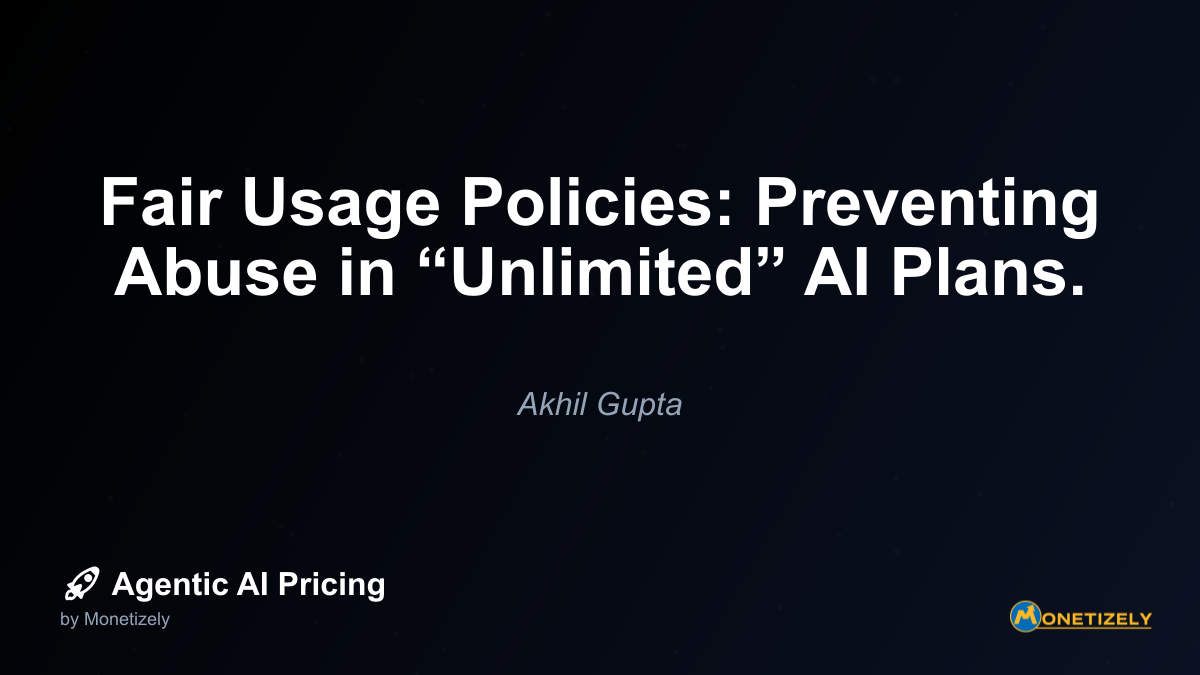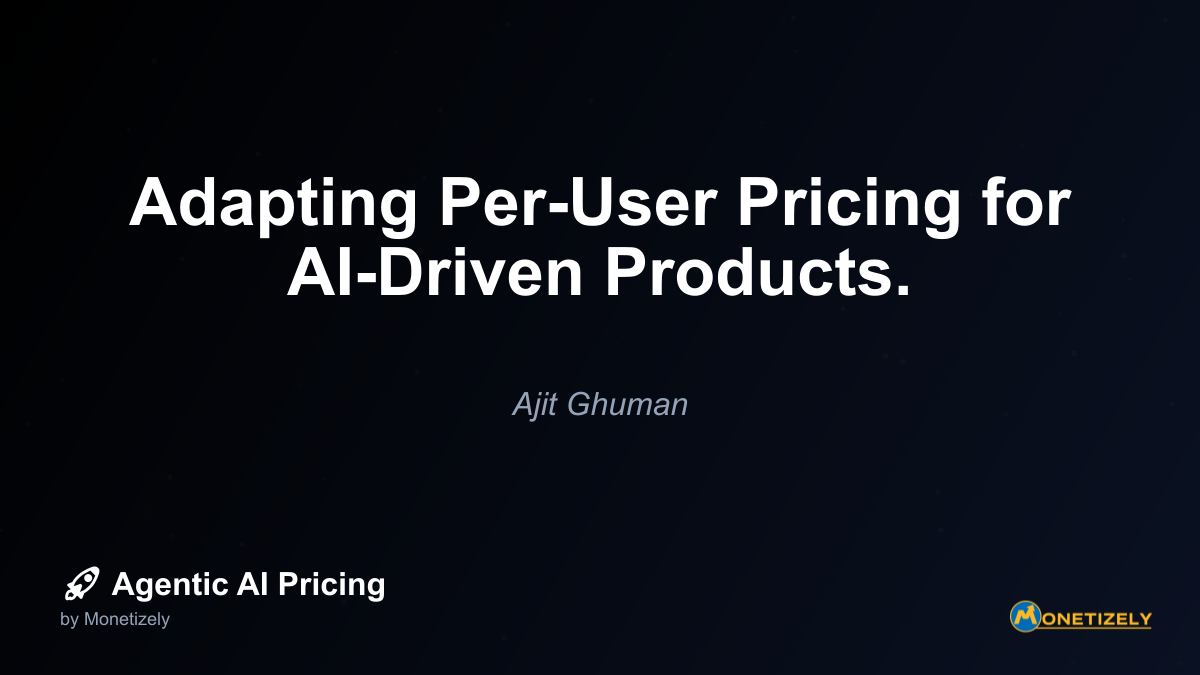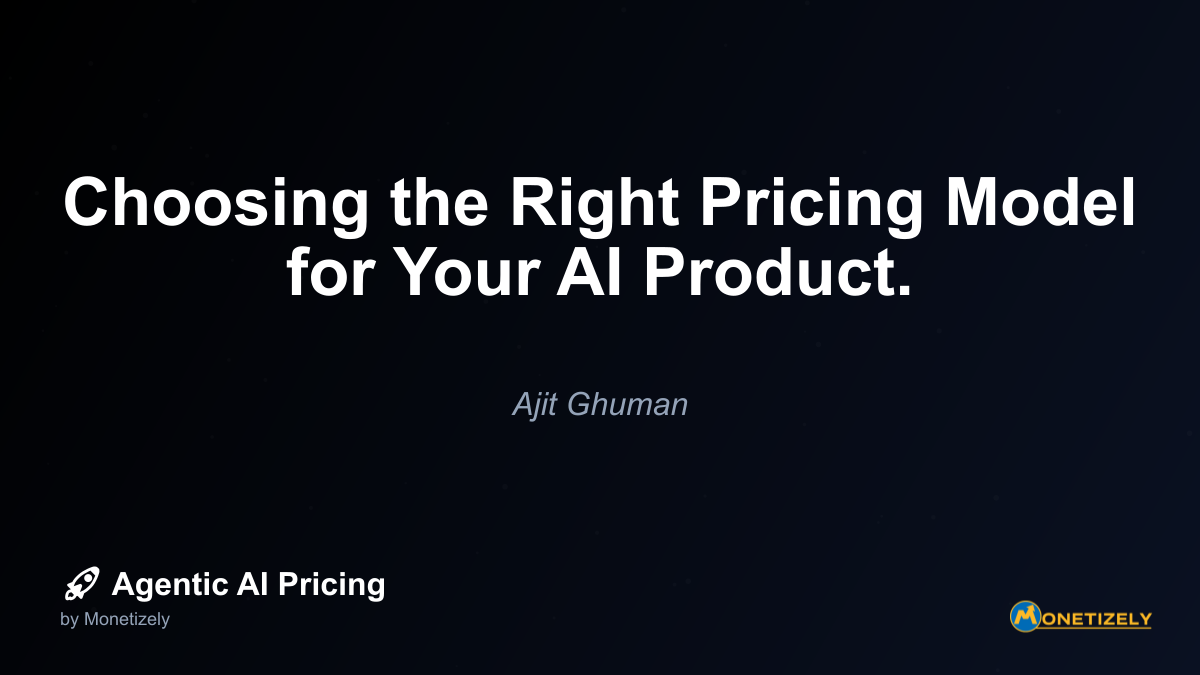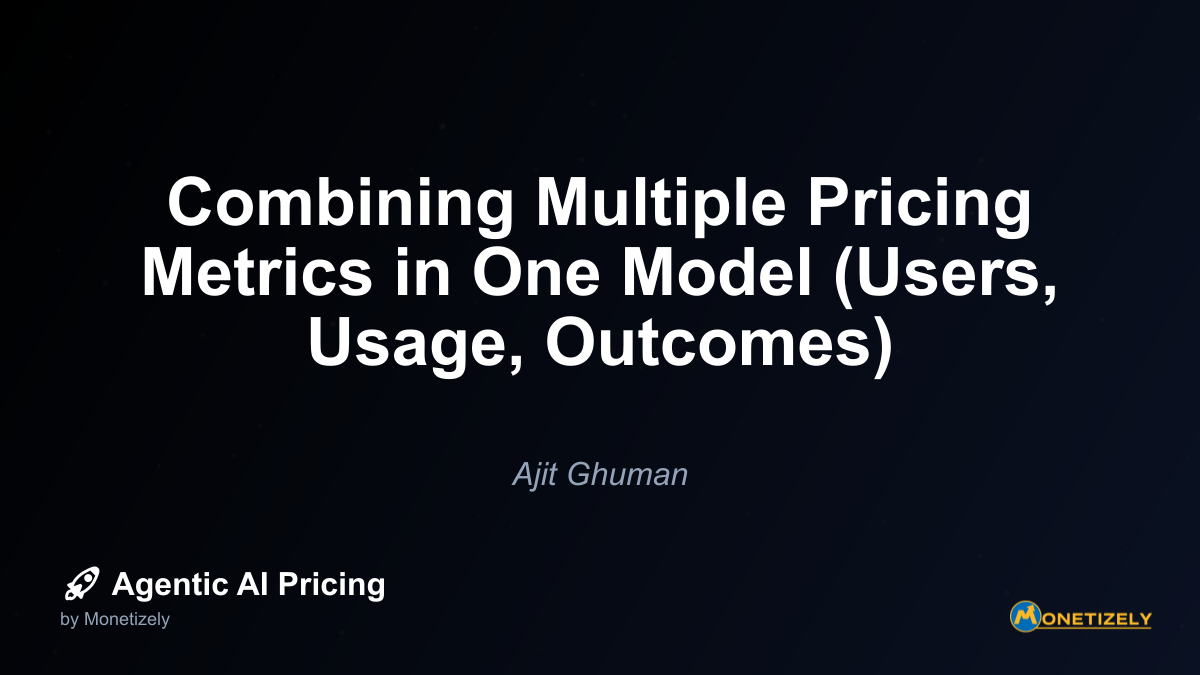· Akhil Gupta · Agentic AI Pricing Strategies · 9 min read
Unlimited Use Plans: Pros, Cons, and Pitfalls.
AI and SaaS Pricing Masterclass
Learn the art of strategic pricing directly from industry experts. Our comprehensive course provides frameworks and methodologies for optimizing your pricing strategy in the evolving AI landscape. Earn a professional certification that can be imported directly to your LinkedIn profile.
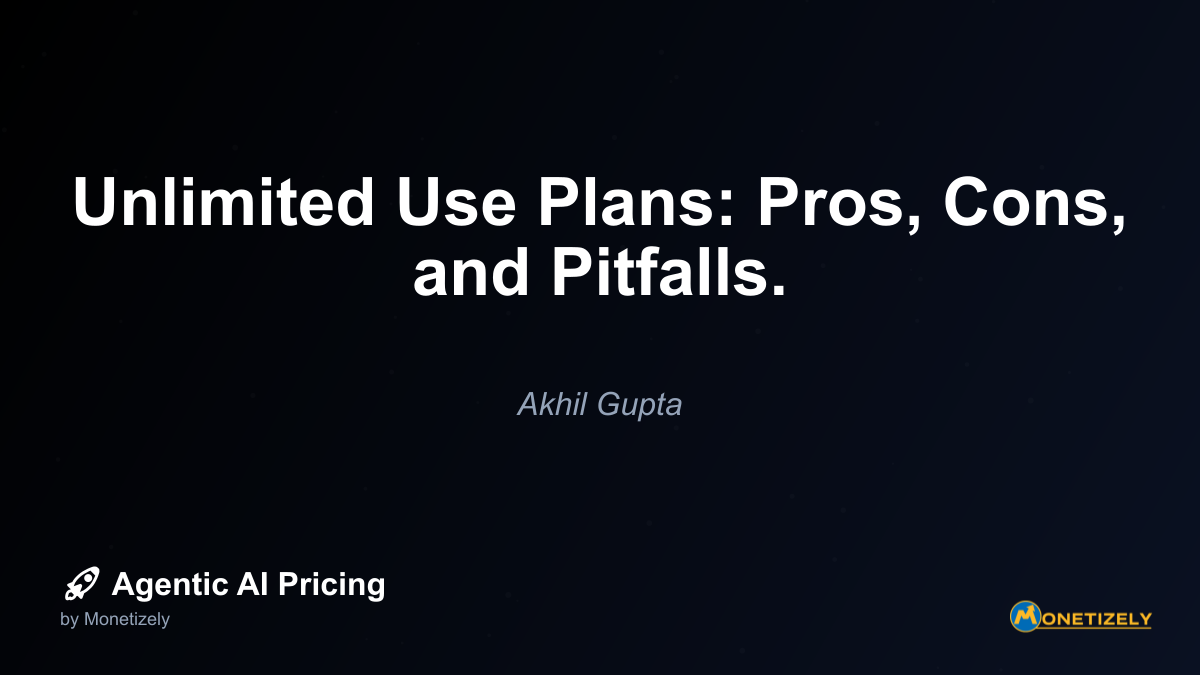
In today’s rapidly evolving AI landscape, pricing strategies for agentic AI services have become a critical consideration for businesses. Among these strategies, unlimited use plans have emerged as a particularly intriguing option. These “all-you-can-use” models promise simplicity and value, especially for high-volume users, but they also come with significant complexities and potential downsides that warrant careful examination.
What Are Unlimited Use Plans in Agentic AI?
Unlimited use plans, also known as flat-fee or all-you-can-use pricing models, offer users unrestricted access to an AI service or platform for a fixed recurring payment. Unlike usage-based pricing that charges per token, API call, or computation time, these plans remove the usage meter entirely, allowing customers to consume as much of the service as they need without incurring additional costs.
In the context of agentic AI—autonomous AI systems that can perform tasks on behalf of users—unlimited plans might cover:
- Unlimited agent executions or runs
- Unrestricted API calls to various tools and services
- Complete access to all available AI models
- No caps on tokens processed or generated
- Unlimited storage of agent configurations and histories
The appeal is straightforward: predictable costs for the customer and simplified billing for the provider. However, the economic realities of delivering AI services make this pricing model far more nuanced than it first appears.
The Appeal of Unlimited Plans
Predictability and Budgeting Simplicity
For businesses integrating agentic AI into their operations, budget predictability represents a significant advantage. With unlimited plans, financial planning becomes straightforward—the cost is fixed regardless of usage fluctuations. This predictability is particularly valuable for:
- Organizations with variable workloads that need to avoid surprise bills
- Companies in growth phases where usage might increase rapidly
- Businesses with seasonal demand patterns
- Finance departments that prefer fixed operational expenses
Encouraging Exploration and Innovation
Unlimited plans remove the psychological barrier of “paying per use,” which can inhibit experimentation. When every API call or agent execution has an associated cost, users naturally become more conservative in their usage patterns.
By eliminating this constraint, unlimited plans can foster:
- More extensive testing of different agent configurations
- Greater willingness to deploy AI agents for novel use cases
- Reduced anxiety about costs when scaling implementation
- Increased likelihood of discovering high-value applications
Competitive Advantage for High-Volume Users
For power users, unlimited plans can offer substantial cost advantages compared to usage-based alternatives. Organizations with high-volume needs—such as those running AI agents for customer service, content generation, or data analysis—may find that their total costs under a usage-based model would far exceed the flat fee of an unlimited plan.
Marketing and Sales Simplicity
From the provider’s perspective, unlimited plans offer a cleaner, more straightforward value proposition. Rather than explaining complex pricing tiers with various usage metrics, the sales message becomes refreshingly simple: “One price, unlimited use.” This clarity can reduce friction in the sales process and make customer acquisition more efficient.
The Hidden Challenges and Risks
The Economic Balancing Act
Despite their apparent simplicity, unlimited plans create a fundamental economic challenge: the provider must set a price point that:
- Appears attractive enough to customers to drive adoption
- Covers the actual costs of service delivery across all customer usage patterns
- Maintains adequate profit margins despite usage outliers
This balancing act is particularly difficult with agentic AI services where:
- The underlying costs (compute, API calls to third parties, etc.) are directly tied to usage
- Different customers may have vastly different usage patterns
- Heavy users can significantly impact profitability
The “All-You-Can-Eat” Dilemma
Unlimited plans suffer from the same economic challenge as all-you-can-eat restaurants: they must price for the heaviest users while remaining attractive to average users. This often leads to one of two problematic outcomes:
Pricing too low: The service attracts heavy users whose costs exceed their revenue contribution, leading to unsustainable losses.
Pricing too high: The service becomes unattractive to average users, limiting market reach and effectively subsidizing heavy users.
For agentic AI services with significant per-use costs, this dilemma is particularly acute. The provider must essentially bet that the average usage across their customer base will remain below a threshold that maintains profitability.
Hidden Caps and Fair Use Policies
To mitigate the risks of unlimited plans, many providers implement less visible restrictions:
- Fair use policies that define “reasonable” usage limits
- Rate limiting that restricts how quickly requests can be made
- Throttling that degrades service for heavy users
- Soft caps that trigger reviews or conversations about usage
These mechanisms create a potential misalignment between customer expectations and reality. What’s marketed as “unlimited” often comes with unstated boundaries that only become apparent when customers push the limits.
The Misuse Risk
Unlimited plans can inadvertently incentivize wasteful or even abusive usage patterns. Without the constraint of per-use costs, customers may:
- Run inefficient agent configurations that consume excessive resources
- Deploy agents for low-value tasks that wouldn’t justify the cost in a usage-based model
- Fail to optimize their implementations to reduce resource consumption
- In extreme cases, resell access or otherwise violate terms of service
For the provider, these behaviors not only increase costs but can also degrade service quality for other customers by consuming disproportionate resources.
Real-World Implementations and Lessons
Case Study: The Evolution of OpenAI’s Pricing
OpenAI’s approach to ChatGPT pricing illustrates the challenges of balancing unlimited access with economic sustainability. While not strictly an agent platform, their evolution offers valuable lessons:
Initial free access: The original ChatGPT offered unlimited free access, creating massive adoption but unsustainable costs.
ChatGPT Plus introduction: A flat monthly fee provided priority access and higher usage limits, but not truly unlimited usage.
API usage tiers: For developers, OpenAI implemented tiered pricing with rate limits rather than true unlimited plans.
This progression demonstrates the difficulty of maintaining unlimited access models in compute-intensive AI services. Even with substantial backing, OpenAI found that some form of usage constraints was necessary for sustainability.
Enterprise Approaches to Unlimited Plans
For enterprise AI services, unlimited plans often take more sophisticated forms:
- User-based unlimited plans: Unlimited usage for a capped number of users
- Scope-limited unlimited plans: Unlimited usage within specific domains or applications
- Tier-based unlimited plans: Different service levels with varying degrees of “unlimited” access
These approaches attempt to square the circle of offering the simplicity of flat-rate pricing while maintaining economic viability.
Best Practices for Implementing Unlimited Plans
For Service Providers
If you’re considering offering an unlimited plan for your agentic AI service, consider these guidelines:
1. Understand Your Cost Structure Thoroughly
Before implementing any unlimited plan, develop a detailed understanding of:
- Fixed costs of service delivery
- Variable costs per user and per usage
- Cost distribution across your customer base
- Usage patterns and potential outliers
This analysis should include stress testing scenarios where usage patterns shift dramatically.
2. Implement Transparent Boundaries
Rather than hiding limits within fair use policies, consider:
- Clearly defined usage tiers with generous but specific limits
- Transparent overage policies
- Published rate limits and throttling thresholds
- Regular usage reports for customers
Transparency builds trust and sets realistic expectations, reducing friction when limits are reached.
3. Consider Hybrid Models
Pure unlimited plans aren’t the only option. Consider hybrid approaches such as:
- Base allocation plus pay-as-you-go for overages
- Unlimited access to basic features with premium features metered
- Time-bound unlimited promotions to gauge usage patterns
- Volume discounts that approach flat pricing for high-volume users
These models can provide much of the simplicity of unlimited plans while maintaining better economic alignment.
4. Build Usage Monitoring and Controls
Robust monitoring systems are essential for managing the risks of unlimited plans:
- Real-time usage tracking and anomaly detection
- Automated alerts for unusual patterns
- Gradual degradation rather than hard cutoffs
- Customer-facing dashboards showing usage patterns
These systems help identify potential issues before they become critical problems.
For Customers Evaluating Unlimited Plans
If you’re considering an unlimited plan for your organization, keep these considerations in mind:
1. Read the Fine Print
Scrutinize the terms of service for:
- Fair use policies and their specific definitions
- Rate limits and throttling thresholds
- Service quality guarantees
- Termination clauses related to usage
Understanding these details helps avoid unpleasant surprises when usage scales.
2. Calculate Your Expected Usage
Before committing to an unlimited plan:
- Estimate your typical and peak usage patterns
- Calculate what your costs would be under alternative pricing models
- Consider your growth trajectory and how usage might evolve
- Identify potential usage spikes or seasonal variations
This analysis helps determine whether an unlimited plan truly offers value for your specific needs.
3. Consider the Total Cost of Ownership
Beyond the sticker price, evaluate:
- Implementation costs specific to the pricing model
- Internal monitoring and management overhead
- Potential costs of hitting undisclosed limits
- Switching costs if the plan becomes unsuitable
These factors contribute to the true cost of adopting an unlimited plan.
Alternatives to Consider
Usage-Based Pricing
The most direct alternative to unlimited plans is pure usage-based pricing, where customers pay only for what they use. This model offers:
- Perfect alignment between costs and value
- Scalability from small to massive usage
- No subsidization across customer types
- Lower barriers to entry for new or small users
However, it comes with the unpredictability that unlimited plans seek to address.
Tiered Pricing
Tiered pricing offers a middle ground:
- Predictable costs within usage brackets
- Some protection against extreme usage variations
- Clearer value communication than pure usage pricing
- Natural upgrade paths as usage grows
This approach can capture many of the benefits of both unlimited and usage-based models.
Reserved Capacity Models
Particularly relevant for compute-intensive AI services, reserved capacity models allow customers to:
- Pre-purchase guaranteed compute resources
- Maintain predictable performance under load
- Pay for capacity rather than direct usage
- Scale predictably within their reserved allocation
This approach shifts the focus from “unlimited use” to “guaranteed availability,” which may better align with actual customer needs.
The Future of Unlimited Plans in Agentic AI
As the agentic AI market matures, we’re likely to see evolution in how unlimited plans are structured and positioned:
Greater Sophistication in Pricing Models
Future unlimited plans will likely feature more sophisticated structures:
- Dynamic pricing based on actual resource consumption patterns
- AI-powered pricing that adapts to individual usage profiles
- Resource allocation markets within enterprise deployments
- Value-based components tied to business outcomes
These approaches will attempt to maintain the simplicity of unlimited plans while addressing their economic challenges.
Increased Transparency and Education
Market education will likely lead to:
- Better customer understanding of the true costs of AI services
- More transparent communication about limits and constraints
- Clearer differentiation between truly unlimited and high-limit plans
- More sophisticated buying behavior from enterprise customers
This evolution will help align customer expectations with economic realities.
Conclusion
Unlimited use plans for agentic AI services offer compelling benefits in simplicity, predictability, and potential value for high-volume users. However, they also create significant challenges in economic sustainability, resource allocation, and alignment of incentives.
For service providers, the key lies in finding the right balance between the marketing appeal of unlimited plans and the economic realities of service delivery. This often means implementing some form of boundaries or hybrid model rather than truly unlimited access.
For customers, the decision requires careful analysis of actual usage patterns and total costs compared to alternatives. The apparent simplicity of unlimited plans should not obscure the need for thorough evaluation of their true value proposition.
As the agentic AI market continues to mature, we can expect pricing models to evolve toward greater sophistication, transparency, and alignment between costs and value. The future likely lies not in pure unlimited plans, but in flexible models that combine the best aspects of different approaches to meet the specific needs of diverse customers.
Co-Founder & COO
Akhil is an Engineering leader with over 16+ years of experience in building, managing and scaling web-scale, high throughput enterprise applications and teams. He has worked with and led technology teams at FabAlley, BuildSupply and Healthians. He is a graduate from Delhi College of Engineering and UC Berkeley certified CTO.
Pricing Strategy Audit
Let our experts analyze your current pricing strategy and identify opportunities for improvement. Our data-driven assessment will help you unlock untapped revenue potential and optimize your AI pricing approach.

